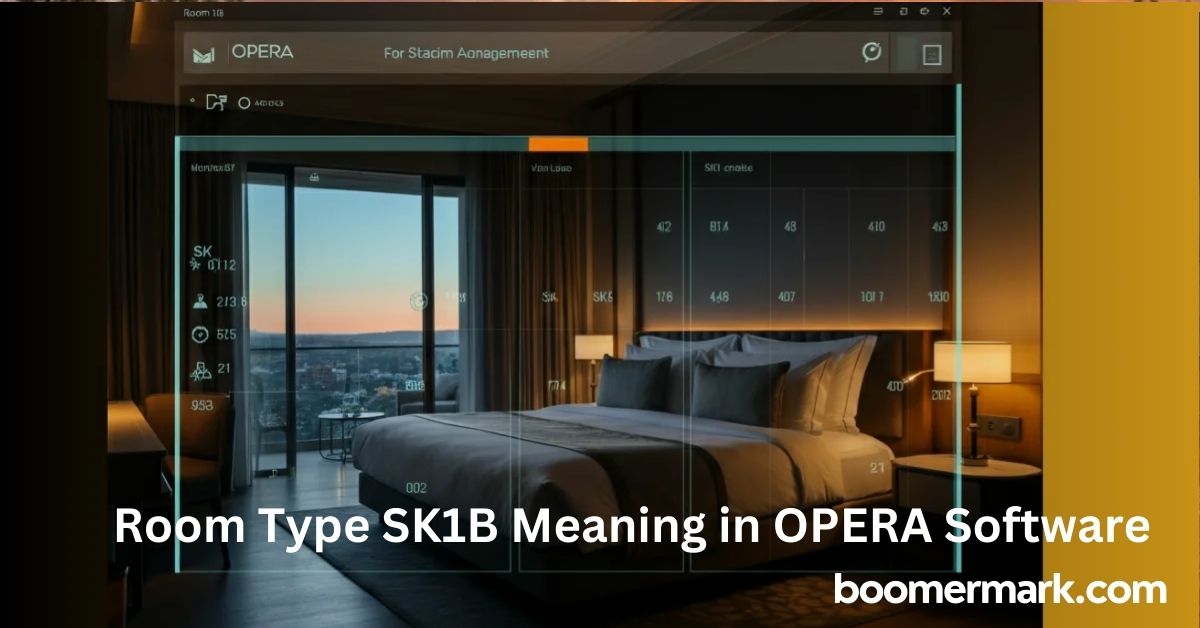The room type SK1B meaning in OPERA software is an essential classification used by hotels to efficiently manage their room inventory and cater to guest preferences. In this article, we will dive deep into what this designation represents, its role in the OPERA Property Management System (PMS), and how it facilitates seamless hotel operations. Whether you’re a hospitality professional or someone curious about hotel management systems, this guide will clarify everything you need to know about “room type SK1B meaning in OPERA software.”
What Is OPERA Software
OPERA is a leading property management system (PMS) widely used in the hospitality industry to manage day-to-day operations. Developed by Oracle Hospitality, OPERA provides hotels with tools to manage reservations, streamline guest profiles, oversee housekeeping, track billing, and generate detailed analytics.
Core Features of OPERA Software:
- Reservations Management: Simplifies the booking process by allowing hotel staff to manage room availability, special requests, and group bookings.
- Guest Profile Tracking: Enables hoteliers to store guest preferences, stay histories, and feedback to enhance personalized service.
- Room Inventory Control: Tracks all room types, including availability, occupancy, and maintenance status.
- Dynamic Pricing: Adjusts room rates in real-time based on demand and inventory levels.
- Integrated Modules: Includes features for housekeeping, food and beverage, and event management, ensuring seamless coordination across departments.
By using OPERA, hotels can improve efficiency, optimize revenue, and provide a superior guest experience.

Understanding Room Types in OPERA Software
Room types in OPERA are unique alphanumeric codes used to classify rooms based on their features and attributes. These codes provide a standard method for organizing and tracking accommodations.
Key Attributes of Room Types:
- Bed Type: Defines the configuration, such as king, queen, twin, or bunk beds.
- Room Size: Indicates the square footage or spaciousness of the room.
- Amenities: Lists features such as balconies, bathtubs, or kitchenettes.
- Location: Specifies whether the room is in a preferred wing, floor, or building.
- Occupancy: Highlights the maximum number of guests the room can accommodate.
For example:
- SK1B: Standard King with 1 Bed, potentially featuring additional attributes.
- DQ2A: Deluxe Queen with 2 Beds in a specific area of the property.
- STSU: Studio Suite with open-plan design.
Room types provide a foundation for pricing strategies, availability tracking, and guest satisfaction.
What Does Room Type SK1B Mean in OPERA Software?
The room type SK1B meaning in OPERA software combines key attributes into a concise code that informs staff about the room’s features. Let’s break down SK1B into its components:
- S (Standard): Refers to the standard category of rooms, indicating a base-level offering with essential features.
- K (King): Specifies the bed type as a king-sized bed, known for its spacious comfort and suitability for single travelers or couples.
- 1 (One): Denotes the number of beds in the room. In this case, one king bed is provided.
- B (Balcony or Building): Indicates a special attribute, such as a private balcony, or the room’s location in a specific building.
Customizing SK1B:
Hotels have the flexibility to tailor these codes to their property’s unique offerings. For instance, one hotel might use SK1B to describe a king room with a balcony and ocean view, while another might apply it to a king room located on the first floor of the main building.
Also Read: Tuscan House 2000s Bloxburg: A Masterpiece of Virtual Architecture
Why Is Room Type SK1B Important in OPERA Software?
The classification of room types like SK1B is crucial for effective hotel management. Here’s why:
1. Accurate Inventory Management
Room type codes enable hotels to monitor availability and occupancy in real-time. This ensures that room assignments align with bookings, minimizing overbookings or underutilized spaces.
2. Enhanced Guest Experience
Precise room descriptions allow hotels to match guest preferences with available rooms. For example, a guest requesting a king bed with a balcony can be easily accommodated in an SK1B room.
3. Dynamic Pricing Strategies
Hotels can optimize revenue by assigning variable rates to room types based on demand. For instance, an SK1B room with a premium view might be priced higher than a standard SK1B.
4. Operational Efficiency
Room type classifications streamline communication between departments. Housekeeping knows which rooms need preparation, and front desk staff can quickly assign rooms during check-ins.
How to Set Up Room Type SK1B in OPERA Software
Setting up room types in OPERA is a straightforward process. Here’s a step-by-step guide:
- Access the Configuration Module: Log in to OPERA and navigate to the “Room Types” section under the configuration menu.
- Define the Attributes: Specify the key features of SK1B, including bed type, occupancy limits, and additional amenities.
- Assign a Code: Use a clear and logical code, such as SK1B, to ensure easy recognition by staff.
- Link to Rate Codes: Integrate the room type with pricing models and availability settings.
- Test the Configuration: Perform a test reservation to confirm that the room type appears correctly in the system.
Also Read: Sophia Li Private Equity: A Journey Through Excellence and Innovation
Related Features of OPERA Software
The room type SK1B meaning in OPERA software is part of a broader set of functionalities designed to enhance hotel operations. Key related features include:
1. Housekeeping Module
Tracks room statuses, such as clean, dirty, or out of order. This ensures efficient turnover of SK1B and other room types.
2. Integrated Channel Management
Synchronizes room types and availability across multiple booking platforms, minimizing discrepancies.
3. Advanced Reporting Tools
Generates insights into room performance, occupancy trends, and revenue generated by specific room types like SK1B.
4. Guest History Tracking
Stores data on past stays, allowing hotels to recommend room types like SK1B based on guest preferences.
Advantages of Using Room Type SK1B Classification
1. Increased Guest Satisfaction
Clear room descriptions help guests make informed decisions, leading to higher satisfaction and fewer complaints.
2. Streamlined Operations
Standardized codes like SK1B make it easier for staff to understand room attributes, reducing errors in assignments.
3. Revenue Maximization
Hotels can upsell premium features associated with SK1B, such as balconies or better views.
4. Consistency Across Platforms
Using the same room type codes across all systems ensures seamless integration and avoids confusion.
Challenges and Solutions
1. Customization Confusion
- Challenge: Over-customization can lead to inconsistent room codes.
- Solution: Implement clear guidelines and training for staff to maintain uniformity.
2. Guest Misunderstandings
- Challenge: Guests may not understand room codes like SK1B.
- Solution: Provide detailed descriptions and images on booking platforms.
3. Data Maintenance
- Challenge: Outdated room configurations can disrupt operations.
- Solution: Schedule regular audits to ensure data accuracy.
Also Read: Alvin Fnaffnaf Gray: The Rising Star in Gaming and Creativity
FAQs About Room Type SK1B Meaning in OPERA Software
Can SK1B be customized for different hotels?
Yes, the room type SK1B meaning in OPERA software can be customized to suit each hotel’s unique offerings and operations.
How do guests benefit from room type SK1B?
Guests benefit from clear and accurate room descriptions, helping them choose accommodations that meet their preferences.
Is SK1B a universal code?
No, SK1B is a customizable code defined by individual hotels within their OPERA systems.
How can SK1B be marketed effectively?
Hotels can highlight features associated with SK1B, such as king beds or private balconies, to attract more bookings.
What happens if SK1B is overbooked?
OPERA’s system suggests alternative room types to ensure guest satisfaction.
Conclusion
The room type SK1B meaning in OPERA software demonstrates how property management systems empower hotels to operate efficiently and meet guest expectations. By understanding this classification, hospitality professionals can enhance inventory management, optimize revenue, and provide a superior guest experience. Whether configuring a new property or refining an existing setup, leveraging the SK1B classification effectively can make a significant difference.
